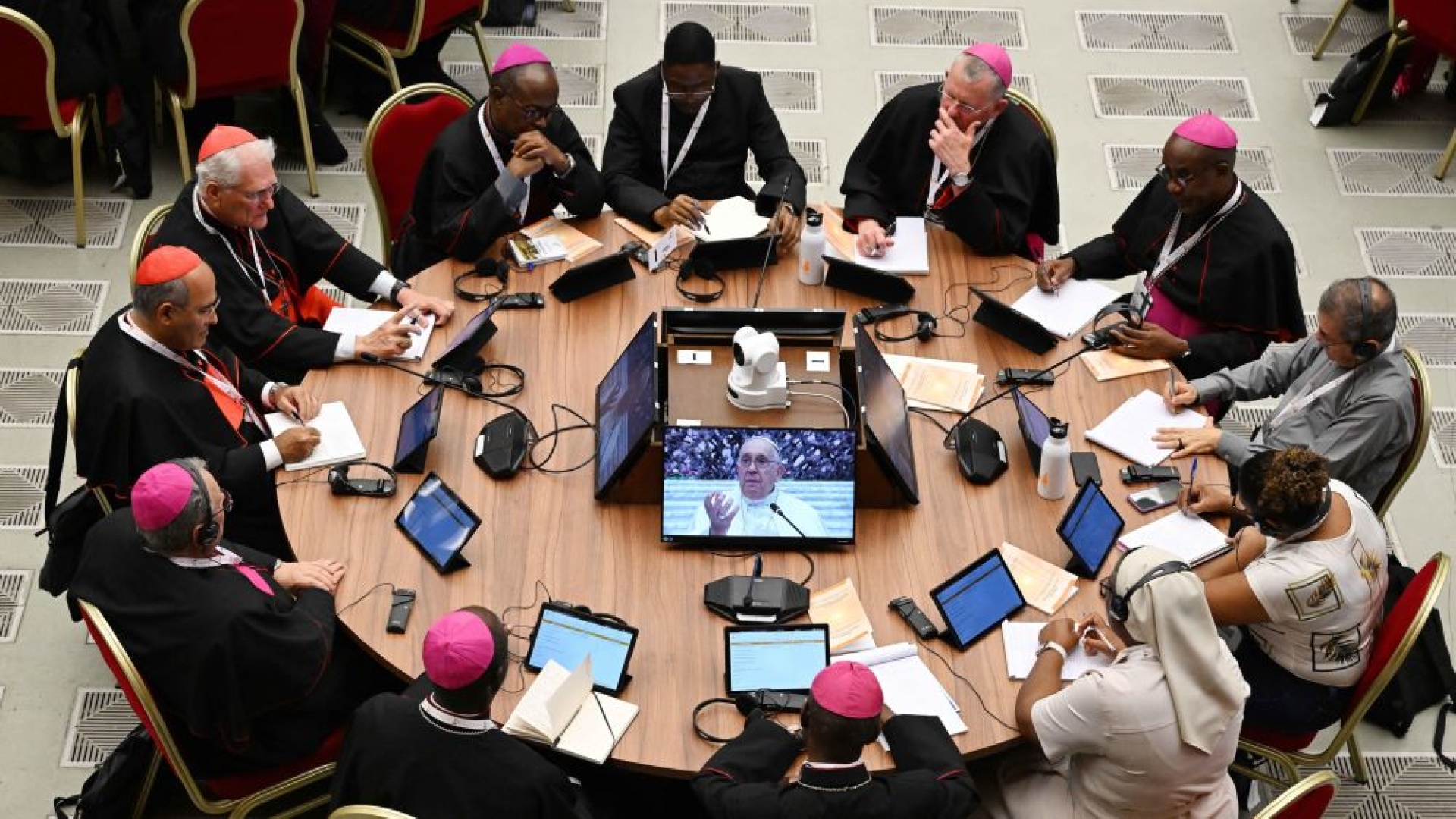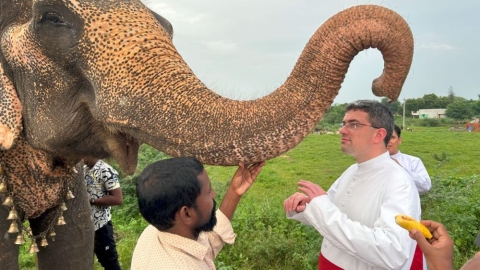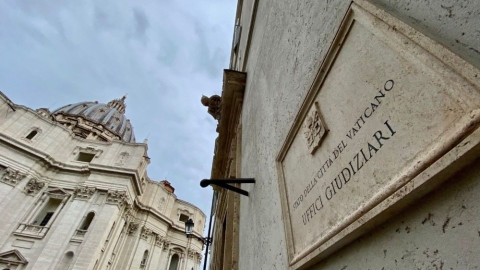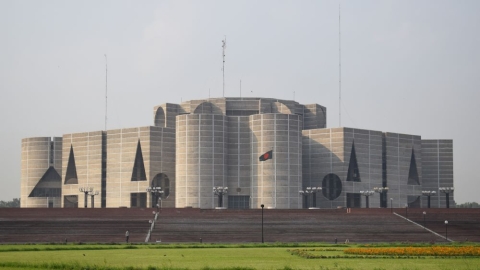Assessment of the First Session of the Synod on Synodality (1)

A minor circle during the Synod
The Synod on Synodality ended on Sunday October 29, the traditional feast of Christ the King. It produced two documents: a short Letter to the People of God and a Summary Report of around 40 pages. Information during the event was provided by regular press briefings which reported on the progress, the subjects discussed, and the main themes of the Synod.
This first article will focus on describing the Synod based on this information and the testimonies that were given by the participants. The prefect of the Dicastery for Communication (DC), Paolo Ruffini, responsible for communicating during the press briefings, recalled several elements about the Synod.
The Assembly and Its Authority
The Assembly had 365 voting members, and around a hundred others present. Thus the Vatican had invited 12 “fraternal delegates” from four Christian traditions: the Oritental Orthodox Churches, the Eastern Orthodox Churches, historic Protestant communions, and evangelical Pentecostals.
The DC President explained the nature and authority of the Assembly: “It is a Consultative Assembly. The episcopal character of the Assembly is not compromised by the presence of members who are not vested with the episcopal munus. This does not change the nature of the Assembly.”
Paolo Ruffini also explained that “the final report will not represent a point of arrival. It will be more of an Instrumentum laboris [a working document].” Later he spoke of a “transitional document.” Finally, the head of communications, regarding the synodal meeting scheduled for October 2024, specified “that we expect that assembly to be the same in terms of members”.
The Synodal Method
The Assembly examined the nature of synodality and its use. In this area there is a fog that is difficult to dissipate: no definition of synodality has been given. Cardinal Gerhard Müller complained about this in an interview given after the Synod.
What emerges – and even more clearly when reading the Summary Report – is that synodality is a practice, as has already been highlighted on this site: “Synodality is not a concept, but an experience of listening, of inclusion.” And on another occasion: “Although everyone wants decisions, the process is more important than the decisions.”
Themes Discussed During the Synod
Clericalism
On Friday October 27, at the end of the Synod, Fr. Timothy Radcliffe, Dominican, Master General of his Order between 1992 and 2001, who preached the pre-synodal retreat of the participants, declared that the recurring theme was criticism of clericalism.
And on Friday, October 20, Sheila Pires, secretary of the Information Committee, clarified that some members of the Assembly were warning against clericalism, even among the laity, because it led to abuses of power, of conscience, economic and sexual.
On Thursday, October 26, Paolo Ruffini reiterated that “the people of God need priests and laity who walk together serenely, without giving in to the temptation of clericalism.” Behind this term we must see an attack on authority in general. The same day Ruffini reported that the Church's commitment to “avoid authoritarianism” had been reaffirmed: authority “is exercised barefoot.”
The abuse of authority seems to be the Pope's primary concern, a concern that he transmits to all the synods, as during his intervention on Wednesday, October 25, where he criticized priests in an unreal way: “It is enough to go to the ecclesiastical tailors of Rome to see the scandal of young priests trying on cassocks and hats or lace albs.” This diatribe caused some embarrassment.
Co-Responsibility
“Co-responsibility” is one of the words that comes up most often in the interventions, and it is understood “as the involvement and coordination of charisms” explained the DC prefect.
A bishop explained about this term: “The Synod on Synodality means thinking together and seeing how the Church can appropriate this concept,” moving “from a Church of a few co-responsible people to a Church where all are co-responsible for the proclamation of Christ and the Gospel, a Church… where everyone expresses their opinion for a final decision which concerns everyone.”
This term “co-responsibility,” which quickly became a leitmotif, was proposed to replace the word “cooperation” which designates the relationship of clerics – priests and deacons – with the bishop of the diocese, in canon law, a revision of which has been requested in particular on this theme.
Another clarification from Paolo Ruffini on Saturday October 21: the “question of discerning decision-making relationships in the relationship between authority and co-responsibility” was addressed. Synodality “does not eliminate authority but contextualizes it,” recalling that “authority is necessary” and that “we must not be afraid to seek confrontation or disagreement.”
The foundation of this co-responsibility is to be found in the baptism which all share, and which makes the whole Church – clerics and laity – co-responsible for the mission. It is clearly stated that, through baptism, all members of the Church are equal. It is the leveling through the refusal of a distinction of divine right between clergy and laity, between priesthood and laity.
Repair the Church
On several occasions there was talk of “revising the structures of the Church.” Thus, “the problem is not only the de-bureaucratization of ecclesial structures, but also the need to devote energy to rethinking new forms and new places of participation in communion and in the millennial history of the Church.”
It is within this framework that it is possible to place discussions about the reform of the clergy and especially concerning bishops. How the episcopate “whose ministry, by the will of the Lord, structures the communion of the Church …must be renewed and promoted” in order “to be exercised in a manner appropriate to a synodal Church” must be examined.
It was thus proposed that the bishop could receive help from collaborators and experts. “The bishop must understand that the diocese is not only him, he cannot do everything alone, but he needs help, perhaps from professionals.”
The way of choosing bishops also came up in the circles. Robert Francis Prévost, prefect of the Dicastery for Bishops, explained that the process remain confidential, but that instructions have been given to include lay people and religious in the examination procedures. The question of married priests was also discussed, as was expected.
The Promotion of Women in the Church
Here is a recurring theme that took several forms: How to ensure “that women feel like they are an integral part of our missionary Church”?
The Synodal Assembly thus discussed the possibility of opening the female diaconate, by first clarifying “the very nature of the diaconate.” Regarding the role of women in the Church, “the question was asked whether it would not be possible to envisage whether women cannot also give homilies.”
LGBT
According to Cardinal Müller, the LGBT theme was omnipresent. It is very discreet in the Summary Report. The general question was: “How can we embody the pastoral care of love for homosexual couples, for divorced people while remaining faithful to the teaching of the Church?” It appears that a directive was given to limit the subject. But this is not to bury it, only to let it mature until the next session.
This first study on the Synod clearly shows the tendency towards the weakening of the hierarchical structure of the Church, with a desire to evolve towards a more “democratic” structure, despite the denial of some.
(Source : Vatican news – FSSPX.Actualités)
illustration : Banque d’images Alamy





